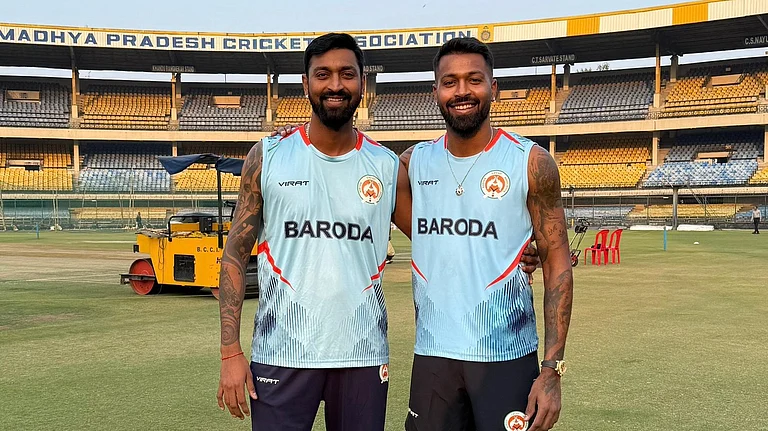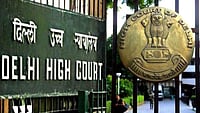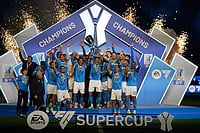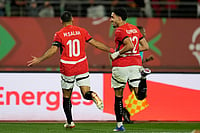THE coalition controversy has dogged Uttar Pradesh's contemporary and past politics. In 1937, the controversy over the Congress-Muslim League coalition widened the cleavage between the two parties in the state and elsewhere. In 1946, the collapse of the Interim Ministry profoundly influenced Uttar Pradesh's politics and society more than any other region. Both were significant landmarks as they paved the way for the country's partition in August 1947.
No doubt the political scenario in Uttar Pradesh has changed from the turbulent decade of the forties. The nature of the political contest has changed. So also the political actors. They are drawn from a wide variety of social classes with a well-defined political and economic agenda. In the past the communal cleavage was a factor in the state. It is much less so now. The conflict and struggle is not between Hindus and Muslim per se, but between the forward castes and the OBCs for a greater share in public employment, institutions and power structures. The Hindutva wave has weakened but has not destroyed caste and class-based alignments. That is why the secular fabric of Uttar Pradesh society remained intact despite the charged communal situation after December 6, 1992.
Yet there are some important lessons to be learnt from the 1937 and 1946 experiences. It is true that the Congress occupied centrestage in the forties, but is currently playing second-fiddle to various regional formations. Still,it may emerge, despite its organisational failings and diminished popular appeal, as a critical force in Uttar Pradesh on the eve of the general elections. Though such a prospect may appear dim at the moment, the Congress may well wrest the political initiative, as it did in the post-World War II period, from a relatively weak and fragmented Opposition. This is contingent upon several factors. Most importantly, if the political misjudgement of the forties is not to be repeated in 1996.
Do you know that the election manifestos of the Congress and the Muslim League in 1937 had much in common? "There is no difference," Jinnah proclaimed on September 18, 1937, "between the ideals of the Muslim League and of the Congress." Do you also know that in Uttar Pradesh the League and the Congresscame to an arrangement in the matter of putting Muslim candidates for the elections? G.B. Pant, Mohanlal Saxena and Abul Kalam Azad had carried out negotiations with their League counterparts and hammered out an agreement. Uttar Pradesh's lieutenant-governor reported in early April that the Muslim Leaguers "are looking forward to an alliance with the Congress and taking office. At present it looks as if the new government will gradually attract a fair number of Muslim Leaguers."
But the expected did not happen. Jawaharlal Nehru threw his weight against a coalition. Some members of the high command executed a volte face. They explained the "breach of faith" in terms of the unexpectedly large Congress majority in the elections, which made all talk of a coalition indefensible. The Muslim League was battered and bruised; theCongress ignored its claims on the assumption that its future was sealed in the state.
The Congress Muslims, too, felt relieved. They opposed the coalition idea in Uttar Pradesh, despite Maulana Azad's retrospective assertion to the contrary, because they were wary of losing their secure and privileged position in the Congress hierarchy to a new set of leaders with a more broad-based political mandate.
We know from our post-Nehruvian experience how excessive political ambition, combined with opportunism, has led to the estrangement of political allies, the disintegration of parties and the resultant fissures in our polity. Much the same happened during the 1937 coalition controversy. It was possible then to tame Jinnah, still struggling to gain a foothold in the shifting sands of Indian politics. He was in a conciliatory mood, ready to strike a deal with the Congress on equal terms. It was equally possible to draw estranged comrades back into the Congress fold and assuage their feelings. After all, there were so many Muslim Leaguers who were not necessarily imbued with an anti-Congress spirit or swayed by the communal clap trap. Finally, a common minimum programme, which the Congress and the League had already agreed upon, could have served as a solid foundation for a coalition government.
Rajendra Prasad referred to large numbers of Congress sympa-thisers among the successful Muslim candidates in the 1937 elections. According to him, the League would not have whipped up the communal animosity later if the coalition issue was settled amicably.
Opinions would differ, but I believe the Congress truculence in the summer of 1937 was a political miscalculation. Its ill-advised decision created the space for the League's revival and offered Jinnah the chance to establish his hold in Uttar Pradesh, a province where Muslims had only just spurned his overtures in the elections. Jinnah returned to Lucknow towards the end of 1937 not as Sarojini Naidu's "ambassador of Hindu-Muslim unity", but as the "quaid" (leader) of the so-called Muslim nation. The two-nation theory was yet to be enunciated, though its contours were being delineated in Jinnah's mind and expressed in public pronouncements.
A coalition ministry was workable in 1937. Not in 1946. The die was cast as the League movement, though founded on the dubious notion of Muslim solidarity, gathered sharpmomentum. The colonial government, headed by inept and cynical viceroys like Mountbatten, was ready to partition the country at short notice and leave behind a violent legacy of Hindu-Muslim conflict and mutual acerbity.
In the light of recent political developments, notably the collapse of the highly opportunistic BJP-BSP alliance and the familiar moves made by other political formations to hammer out an agreement with like-minded groups, it is important to be reminded of what happened in 1937 and 1946. Uttar Pradesh matters because of its demographic weight and consequent political clout. The future of the Congress, as also of various caste-based alliances, rests in the state. The fate of the Hindutva campaigns will be decided by the electorate there. Above all, it would decide whether India remains 'secular' or not.


























